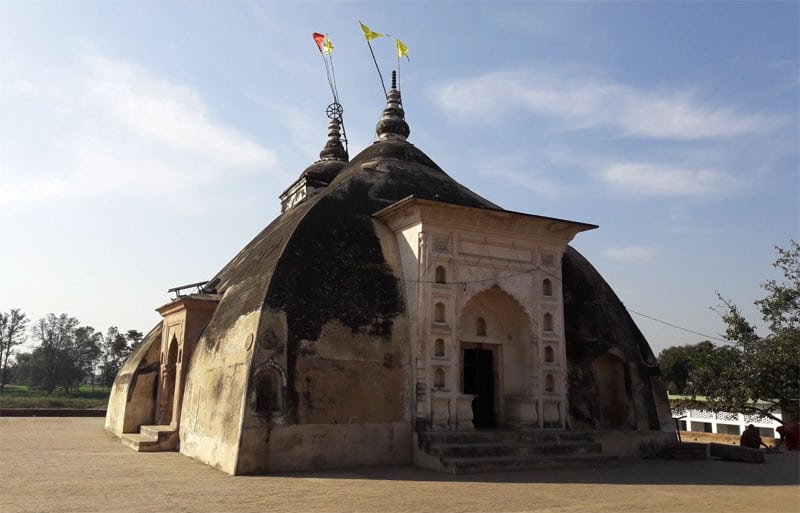
Spirituality
Rain predicting Jagannatha temple of Kanpur
There are about a hundred and fifty million farmers in India. Until a few years ago, the Indian economy was based on agriculture and related business. This national profession was solely dependent upon the highly unpredictable monsoon. It won’t be far-fetched to say that the monsoon decides the yearly GDP of this vast nation, but due to its uncertain nature, farmers used to suffer a lot.
Ancient Indians came out with specific methods based on bio indications, devotion, and faith to predict the yearly rainfall to encounter this unpredictability. By observing the Nandi Bail (rain predicting bull), bees, full moon, or rainbows, ancient Indians predicted the rainfall for generations. Today, in the blog series of mysterious temples of India, we will visit a rain prediction of the Jagannatha temple of Kanpur, predicting showers for hundreds of years.
The temple
Bhitargaon is a town in Kanpur district, Uttar Pradesh. It is famously known for its most ancient brick-made Lord Shiva temple from the Gupta period. Travelling three km further, you reach the small village of Beheta, which is also famous for its temple. Thousands of farmers gather here to listen to the rain predictions every year.
The temple has a rather unusual structure with a semi concave roof, like a turtle’s back. As per the Archeological Survey of India, the last renovation was done in the eleventh century. The temple has a vast courtyard and a narrow entrance. The temple entrance is decorated with door frames adorned with minute carvings.
On the outer walls, one can see the carvings of a peacock and chakra, suggesting that the temple might have been erected during Chakravarti Samrat Harshavardhana, making this temple about 1400 years old. Temple might look like a Stupa (Buddhist temple), but with Hindu markings. Inside the sanctum sanctorum, a small Vigraha (consecrated Idol) of Lord Jagannatha blesses the farmers.
Rain Predictions
Devotees coming to the temples are primarily farmers from nearby villages and towns who come here to pray for good rain. Predicting the showers is the job of the Meteorological department. Still, due to the highly unpredictable nature of the monsoon, no supercomputer on earth can predict it correctly so that farmers can plant their crops. And hence, many farmers come here regularly, at the doorsteps of lord Jagannath, to learn about the rains and plan their crops accordingly.
Temple priests and farmers look for the water droplets accumulated on the ceiling above the Lord Jagannatha Vigraha. If the droplets are more significant, the monsoon will be good. If the water droplets are smaller, the monsoon will be below average. The monsoon begins precisely seven days after the water droplets accumulate on the ceiling. As per the devotees and priests, the temple indications never have been wrong. The temple predicts the rain correctly each season.
Monsoon and Spirituality
The monsoon nourishes the Indian subcontinent. In Indian literature, the bird Chaataka has been considered the harbinger of the rains. Charaka, also known as pied cuckoo, is an African bird, which lives in the Sahara desert, and arrives in India just before the monsoons. It waits for the monsoon and only quenches its thirst by drinking the rain droplets falling directly from the dark clouds if it arrives early.
While depicting the importance of monsoon, legendary poet saint Tulsidas wrote,
गंगा यमुना सरस्वती सात समंदर भरपूर
तुलसी चातक के मते बिन स्वाति सब धूर
The holy river Ganges, Yamuna, and Saraswati, along with the seven seas, has plenty of water. But, everything without the drop of rain is just a speck of dust for the Chatak bird, O’ dear Tulasi.
Chatak bird keeps its beak open and points toward the sky, hoping to catch a drop of monsoon, which happens during the Swati Nakshatra (constellation). If the monsoon is late, the bird could keep his beak open for months but does not drink water from a pond or river. This is the true sign of an intense desire.
And saint Tulasidas suggests, as the Chatak bird has his intense desire for the monsoon drops, one must have a sincere desire to be the one with the Divine. After the long wait, the monsoon arrives, quenches the thirst of that little bird from Africa, and nourishes the entire Indian subcontinent.
We hope you enjoyed reading about the mystical rain-predicting temple of Lord Jagannatha, located in the colourful city of Kanpur. Please subscribe to our mailing list to stay connected and receive information about spirituality. In case of any queries, please write to us at info@chamundaswamiji.com. You can check out our YouTube channel Chamunda Swamiji where you can learn Tantra, Mantra, Yantra, and Meditation from His Holiness Shri Chamunda Swamiji.
Post a Comment
-
Subscribe to Our Blog
-
Categories
-
Popular Articles
- Dead moth in the house. What universe is trying to tell you?
- Spiritual Meaning of Moth
- Vivah Bandhan Curse – What Is It and How to Spiritually Heal It.
- The Dasa Mahavidyas
- What are Beej Mantras?
- Tripura Sundari | The Dasa Mahavidya
- Maa Bhuvaneshwari | The Dasa Mahavidyas
- The Five Shades of Tantra
- Ramakrishna Paramhansa – The Man who almost became a Woman
- Maa Chinnamasta | The Dasa Mahavidyas



